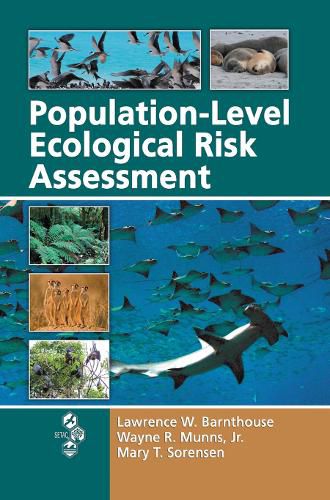Readings Newsletter
Become a Readings Member to make your shopping experience even easier.
Sign in or sign up for free!
You’re not far away from qualifying for FREE standard shipping within Australia
You’ve qualified for FREE standard shipping within Australia
The cart is loading…






Most ecological risk assessments consider the risk to individual organisms or organism-level attributes. From a management perspective, however, risks to population-level attributes and processes are often more relevant. Despite many published calls for population risk assessment and the abundance of available scientific research and technical tools assessing risks to populations, risk assessors worldwide still have difficulty determining how population level considerations can be integrated into environmental decision-making.
Population-Level Ecological Risk Assessment establishes a framework for goals, methods, and data needs for different assessment applications and for integrating population-level risk assessment into risk management decisions. Beginning with a summary of legal, regulatory, business, and other contexts, the book presents population-level ecological risk assessment as an internationally recognized, science-based tool and offers specific recommendations for using this tool to support environmental management decisions. It gives clear, explicit, operational population assessment definitions and explains the relevance of density dependence, genetics, and spatial considerations, as well as applicable lessons from conservation biology and natural resource management.
The authors provide a tool box of empirical and modeling methods and describe the general approaches, assumptions, data requirements, strengths, and limitations of each method. They establish a working foundation for designing and conducting population-level ecological risk assessments consistent with North American, European, and Japanese risk management approaches. The book concludes by highlighting key considerations needed to improve the scientific quality and interpretation of assessments. Detailed appendices include examples of population-level assessment approaches applicable to specific environmental management contexts, a modeling case study, and a supplemental r
$9.00 standard shipping within Australia
FREE standard shipping within Australia for orders over $100.00
Express & International shipping calculated at checkout
Most ecological risk assessments consider the risk to individual organisms or organism-level attributes. From a management perspective, however, risks to population-level attributes and processes are often more relevant. Despite many published calls for population risk assessment and the abundance of available scientific research and technical tools assessing risks to populations, risk assessors worldwide still have difficulty determining how population level considerations can be integrated into environmental decision-making.
Population-Level Ecological Risk Assessment establishes a framework for goals, methods, and data needs for different assessment applications and for integrating population-level risk assessment into risk management decisions. Beginning with a summary of legal, regulatory, business, and other contexts, the book presents population-level ecological risk assessment as an internationally recognized, science-based tool and offers specific recommendations for using this tool to support environmental management decisions. It gives clear, explicit, operational population assessment definitions and explains the relevance of density dependence, genetics, and spatial considerations, as well as applicable lessons from conservation biology and natural resource management.
The authors provide a tool box of empirical and modeling methods and describe the general approaches, assumptions, data requirements, strengths, and limitations of each method. They establish a working foundation for designing and conducting population-level ecological risk assessments consistent with North American, European, and Japanese risk management approaches. The book concludes by highlighting key considerations needed to improve the scientific quality and interpretation of assessments. Detailed appendices include examples of population-level assessment approaches applicable to specific environmental management contexts, a modeling case study, and a supplemental r